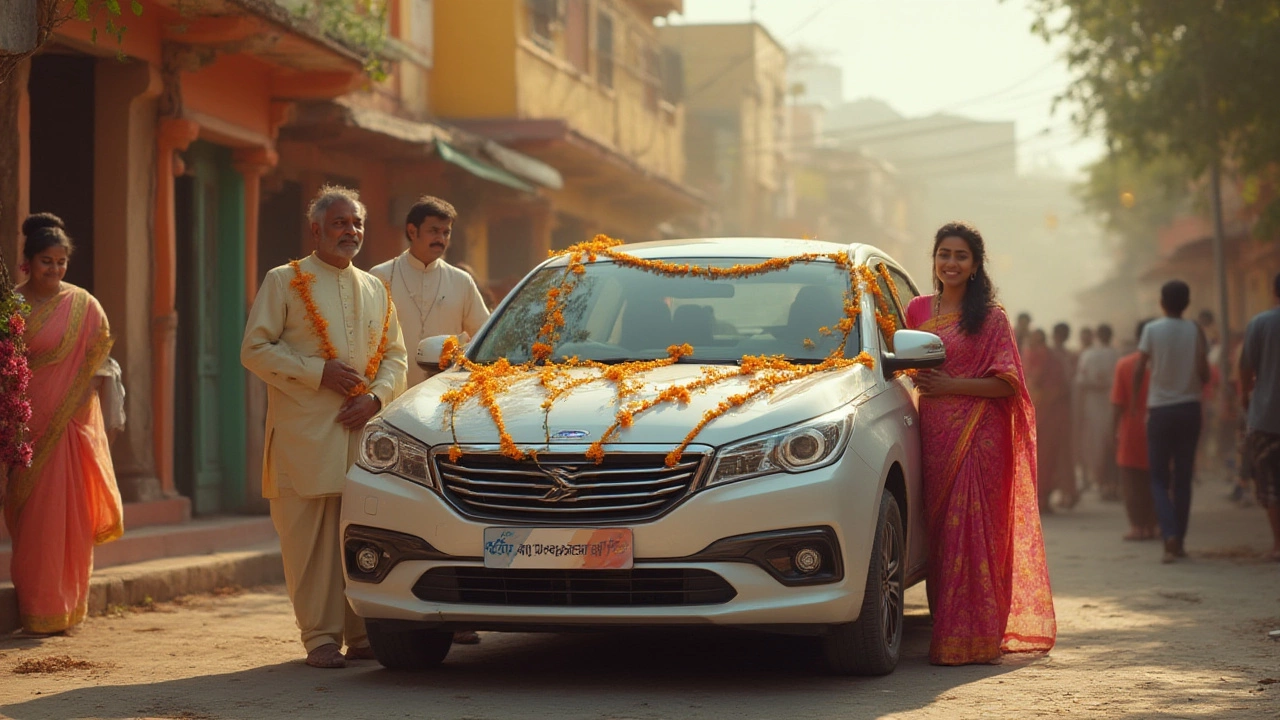There’s this one heated debate that almost everyone in my WhatsApp groups gets into—especially the dads—when we talk about dream cars, patriotism, and the temptation to save a few lakhs by going vocal for local. The big question: Which car is really, truly, fully made in India? Sort through the marketing slogans, flashy presentations, and you’ll find the truth is complicated, packed with trivia, proud moments, and a few head-scratchers. I remember Ishaan, my 12-year-old, asking me at a traffic light if the car in front was "total Indian" or just pretending. Tells you something about curious minds.
The Meaning of “Fully Made in India” – More Than Just Assembling Parts
People often think if a car is built or even just screwed together inside an Indian factory, it counts as “Made in India.” But here’s where things get interesting—it depends on WHAT you mean. If you want the car to be not only built in India but also designed, engineered, and every tiny nut and bolt sourced from Indian suppliers, your list shrinks dramatically. Most of the big names—Hyundai, Maruti Suzuki, Honda, Kia—assemble and even make a lot of parts here. But they all import high-value stuff like engines, ECUs, transmission assemblies, and those complex electronics. Even so, some companies have managed to localize nearly 95% of their components over years. So you’ll hear the term “levels of localization” being thrown around, with numbers like 75%, 85%, and—sometimes—an impressive 98%. The thing is, absolute 100% is almost mythical.
Let’s break down what a "fully made in India" car actually looks like. The real deal needs these boxes checked:
- Design and engineering in India
- All parts sourced or made in India (even microchips and ECUs, which are tough)
- Manufacturing, assembly, and testing happen in local plants
- Built by an Indian company, not just manufactured here by a multinational
- Sales and export (if any) are managed from India
Here’s a fun twist—India is actually the world's fourth largest car market, and it's home to dozens of car manufacturing plants cranking out millions of units a year. Tata Motors, Mahindra & Mahindra, and Ashok Leyland are three homegrown names that fully fit the "Made in India" bill for most (not all) of their models. A little-known fact: Tata started out making trains and buses. Mahindra? Originally assembled Jeeps. Both now make cars from ground up, with some models touching 98–99% local content. That’s miles ahead of imported knockdown kits that are bolted together locally.
Spotting a fully Indian car in the wild is part knowledge test, part detective work. Some models like Tata Tiago, Tata Nexon, Tata Punch, Mahindra XUV700, and Mahindra Thar are almost entirely Indian, from the design board in Pune or Mumbai to the stamping presses of Jamshedpur. Tata’s steel comes from Tata Steel (shocker, right?), so even the raw material is Indian. Mahindra boasts its own engines, gearboxes, and even infotainment systems from Indian subsidiaries. That said, sometimes things get blurry with top-end gadgets, imported chips, or German turbochargers sneaking in. Still, these brands get about as close as you can get to a proper Indian ride.
Let’s look at some component localization figures for recent Indian-made vehicles:
| Model | Localization (%) | Key Indian-Crafted Areas |
|---|---|---|
| Tata Nexon | 95–98 | Body, engine, transmission, interior, electronics (most) |
| Mahindra XUV700 | 90–95 | Chassis, powertrain, body, trim |
| Maruti Suzuki Alto | 90–92 | Sheet metal, plastics, most mechanicals |
| Kia Seltos | 80–85 | Body, interior, some electronics |
| Hyundai Creta | 80–85 | Body, interior, engine (localized variants) |
Here’s what blows my mind: India is now exporting cars to even developed countries. Slap a Tata or Mahindra badge on a car, and someone in Africa or Europe might just have it in their driveway. Ford and General Motors actually used India as their production and export base—until the head office pulled the plug, leaving fans with some very affordable used Fords and Chevys. Turns out, Indian labor and supply chains can deliver high quality at prices that outsmart Europe or the US.

Meet the Brands: Tata, Mahindra, and the Legendary Indian Machines
Now, if you ask any car geek about homegrown Indian cars, two companies pop up: Tata and Mahindra. Both are not just popular in showrooms—they’re stuffing Indian roads and even winning awards. Here’s a breakdown of each and what makes their cars “local” to the bone.
Tata Motors is the pride of every Indian dad who ever drove a rugged Sumo or Indica. These days, the Nexon and Punch are everywhere, and for good reason. Their designs come from studios in India, the engineering is local, the crash tests are done right here, and the bulk of their value—metalwork, engine, interiors—happens within 300 km of Pune or Sanand. Tata even makes its own batteries for EVs, and sources high-end, locally-made alloys. Some of the first-ever Indian cars to get five-star safety ratings are Tatas—real bragging rights at those family reunions. By the way, the Tata Nano, the famous one-lakh car, broke headlines around the world for being “people’s car” and entirely Indian-made.
Mahindra & Mahindra goes way back to building Jeeps for rugged Indian roads. Now, the Thar has cult status, and the XUV700 looks like something German. They use Indian designs, in-house engines, and even export tractors and SUVs globally. Drivers love their durability: just ask any taxi fleet manager. The XUV700 and Thar aren’t just local hits; they’ve been exported to South Africa, Australia, and parts of Europe. Even electric vehicles (EVs) like the Mahindra eVerito—one of India’s first compact electric sedans—are built with maximum local input. And for those who like off-roading, Mahindra’s all-Indian 4x4s are basically the reliable horses of every adventure trail across the Himalayas and Rajasthan deserts.
Let’s talk about Maruti Suzuki for a second. Suzuki, a Japanese company, but their Alto, Swift, and WagonR models? They’re true workhorses of India with around 90% localization. They’ve invested billions in local suppliers, trained staff, and even designed variant models specifically for Indian buyers. The newest Jimny is put together in Gurgaon, but key components like gearboxes and some electronics still ride in from Japan. If you’re looking for “most Indian” Maruti models, start with the Alto and WagonR—they’re cheap to build, easy to maintain, and loaded with Indian-sourced bits, right down to the bolts.
Some wild cards? Ashok Leyland, usually known for buses, has made waves with locally developed commercial vehicles and trucks. They design, engineer, and test in Chennai, supplying everything from city buses to army trucks, all within India.
Then you have startups like Ola Electric and Ather churning out e-scooters in massive Indian plants. Their motorcycles and scooters aren’t "cars," but they’re 90–95% local by weight, showing that full-scale Indian automotive manufacturing isn’t just a dream anymore—it’s moving fast, especially in the electric segment.
Worth knowing: Indian carmakers are not just chasing lower costs. They are investing big time in R&D, crash safety, green tech (like EVs), and manufacturing robots. Tata, for example, invested over ₹3,800 crore the past three years in their homegrown electric vehicles platform. Mahindra is working on modular platforms to switch between petrol, diesel, and electric in the same assembly line—the kind of flexibility most German plants envy!
So, your real “Made in India” car is most likely to come from Tata Motors, Mahindra & Mahindra, or Ashok Leyland (if you don’t mind buses or trucks). They tick almost every box, and when you buy one, you’re boosting Indian jobs, tech, supplier networks, and—yeah—family bragging rights. Don’t forget to read those tiny engine bay stickers next time you pop the hood—they tell great stories!

What the Future Holds: Indian Cars and the Quest for True 100% Local Content
This is pretty wild—India’s annual car production hit around 4.6 million in the 2024–2025 financial year, with exports climbing every quarter. Indians are not just buying more cars; the world now looks to India for affordable, well-engineered, and practical vehicles. That’s a giant leap from the days when Ambassador and Premier Padmini ruled Mumbai streets, belching smoke but carrying three generations at once. These days, even European brands like Peugeot, Citroën, Volkswagen, and Kia have set up huge plants in India mainly to serve local and export demand. Their cars are ‘Made in India’ by label, but only partially in the true sense.
The gap between “almost fully” and “truly 100%” Indian cars mostly comes down to technology—especially high-tech chips, sensors, advanced batteries, and turbochargers. India imports a lot of semiconductors because manufacturing these is a mammoth task, needing billion-dollar fabs and years of R&D. Still, there’s movement: in 2024, a bunch of fresh semiconductor plants came up in Gujarat and Telangana. Indian firms are now designing and even fabbing some of their own auto chips, which means the dream of a true 100% local car isn’t as distant as it felt just a few years ago.
Tata’s latest EVs are tipping the scales—95–97% of all parts, including batteries, are made at Indian facilities. Mahindra’s next-gen SUVs plan to cross the 95% mark with fully Indian software, locally sourced batteries, and even homegrown infotainment systems. Even better, the government is throwing its weight behind the idea. With schemes like PLI (Production Linked Incentive) and Make in India, homegrown car brands get big cash-back deals for hitting local content targets. There’s also a new push for green components—Indian-made batteries, electric drivetrains, and lightweight alloys are the next big localization frontier.
Let’s not forget how this affects real people—every “true Indian” car supports a web of Indian suppliers, from small machine shops in Aurangabad to plastics factories in Haryana. It’s massive for the economy and creates jobs for everyone from design geeks to steelworkers (one reason Tata and Mahindra have nearly 200,000 direct employees between them).
On the customer side, choosing a car with max Indian content saves you money, earns maintenance points at local garages (who actually get the wiring diagrams!), and means those tricky parts aren’t stuck in customs. As a dad, I love that Ishaan can spot a Tata Punch and rattle off that it’s “almost all Indian.” It’s a neat bit of pride, and honestly, it feels good knowing your purchase keeps your own country in business.
So, are there any cars that are 100% Indian? Probably not yet, unless you count handmade one-offs or commercial vehicles with zero imported tech. But Tata and Mahindra are as close as you can get in 2025, with models like Nexon, Punch, Thar, and XUV700 routinely crossing 95–98% local content. The rest of the market, from fancy Audis to budget Renaults, just won’t get there soon because of global supply chains—at least, not for a few more years. But the gap shrinks with every new localization drive at home.
It’s a cool time to buy Indian: you support jobs, get value, and sometimes—just sometimes—give your family a story to tell at the next red light. If in doubt, just ask the kids. They’ll always spot the Tatas and Mahindras first, and honestly, that’s half the point.
